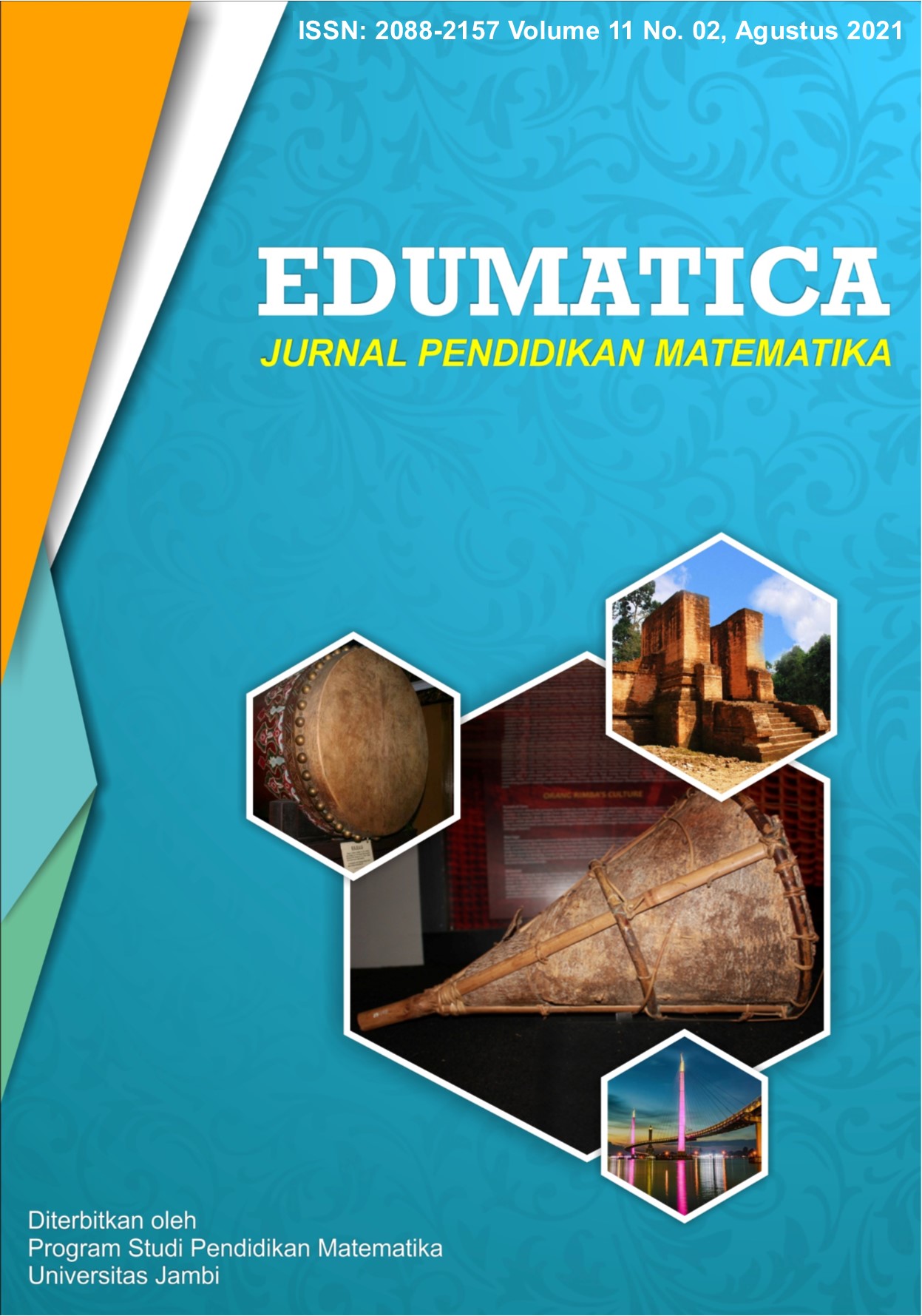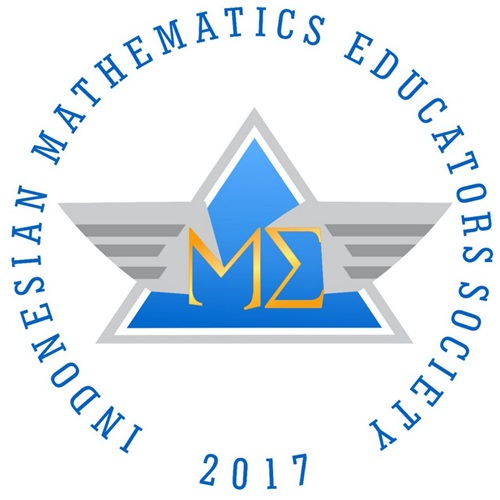Ability to Understand Student Mathematic Concepts in SPLDV Materials Using SOLO Taksonomi Based Problems
DOI:
https://doi.org/10.22437/edumatica.v11i02.12156Keywords:
ability to understand mathematical concepts, SOLO taxonomyAbstract
Story questions have level of abstraction characteristics. In the story question, it can be seen that the student' abstract extended level by changing the pattern questions according to the indicators of high-level mathematical thinking. This study aims to determine the ability of students to understand mathematical concepts in the SPLDV material using SOLO Taxonomy-based questions and student responses in working on these questions. When researchers did a teaching practice at a vocational high school in Cirebon district, they found that the students' ability to understand concepts was still low, this was confirmed by interviews with students that they did not understand SPLDV questions, especially in making mathematical models of a story problem. This research is located in one of the Vocational High Schools in Cirebon Regency. The subjects of this study were 21 class X students. The researcher used a descriptive method with a qualitative approach because the researcher wanted to find out more about how students understood mathematical concepts in the SPLDV material using SOLO Taxonomy-based questions. The results of this study were the students' ability to understand mathematical concepts in the SPLDV Material Using SOLO Taxonomy-based questions was still very low, namely 37.10% and the responses given by students were positive for the use of questions based on the use of SOLO Taxonomy-based questions.
Downloads
References
Asikin, M. (2002). Pengembangan Item dan Interpretasi Respon Mahasiswa dalam pembelajaran Geometri Analit Berpandu pada Taksonomi SOLO. Jurnal Pendidikan dan Pengajaran IKIP Negeri Singaraja. 36(04)
Biggs,J,B & Collis,K,F.(1982). Evaluating the Quality of Learning. Australia: Academy Press. Retrieved from retrieved from https://books.google.co.id/books?hl=id&id=xUO0BQAAQBAJ&oi=fnd&pg=PP1&dq=info:HGagMPunKd8J:scholar.google.com/&ots=appyhXOnPe&sig=KsWFtgs6408jHDakGc0kXUZeK9s&redir_esc=y#v=onepage&q&f=false
Claudia, L. F., Kusmayadi, T. A., & Fitriana, L. (2020). The SOLO taxonomy: classify students' responses in solving linear program problems. In Journal of Physics: Conference Series 1538(1). 012107
Evijayanti, W., & Sutiarto, S. (2019). Analysis Of Vocational High School Students About Difficulty In Completing The Spldv Problem Viewed From Mathematic Communication Ability (2132). EasyChair. Retrieved From https://easychair.org/publications/preprint_download/qnqT
Pratiwi, N. D., (2015). Pengembangan Instrumen Evaluasi Berbasis Taksonomi Structure of the Observed Learning Outcome (SOLO) Untuk Menentukan Profil Kemampuan Siswa dalam Memecahkan Masalah Fluida Statis. Jurnal Inovasi Pendidikan Fisika, 4(3).
Ekawati, R., Junaedi, I., & Nugroho, S. E. (2013). Studi respon siswa dalam menyelesaikan soal pemecahan masalah matematika berdasarkan taksonomi SOLO. Unnes Journal of Mathematics Education Research, 2(2).
Firmasari, S., & Aminah, N. (2016). Analisis Pemahaman dan Penalaran Matematis pada Perkuliahan Teori Bilangan menggunakan Teknik Superitem. Prosiding Seminar Nasional dan Pendidikan Matematika (pp.1013). Retrieved From http://fkip-unswagati.ac.id/ejournal/index.php/repository/article/viewFile/343/306
Hasan, B. (2017). Karakteristik Respon Siswa dalam Menyelesaikan Soal Geometri Berdasarkan Taksonomi SOLO. JINoP (Jurnal Inovasi Pembelajaran), 3(1), 449-458.
Kaharuddin, A., & Hajeniati, N. (2020). An Identification of Students' Responses Based on Solo Taxonomy in Mathematics Learning Toward Learning Activities and Learning Outcomes. Al-Jabar: Jurnal Pendidikan Matematika, 11(2), 191-200.
Kholidah, I. R., & Sujadi, A. A. (2018). Analisis pemahaman konsep matematika siswa kelas V dalam menyelesaikan soal di SD Negeri Gunturan Pandak Bantul tahun ajaran 2016/2017. Jurnal Trihayu, 4(3), 259074.
Kilpatrick, J., Swafford, J., & Findell, B. (2001). Adding it up: Helping children learn mathematics (2101). National research council (Ed.). Washington, DC: National Academy Press.
Maryulianty, L. (2019). Analisis Tingkat Kemampuan Siswa dalam Menyelesaikan Soal Cerita Sistem Persamaan Linear Tiga Variabel Berdasarkan Taksonomi SOLO. Numeracy Journal, 6(1), 153-165
Marisa, G., Syaiful, S., & Hariyadi, B. (2020). Analisis Kesalahan Siswa Dalam Menyelesaikan Soal Operasi Aljabar Berdasarkan Taksonomi SOLO. Jurnal Pendidikan Matematika, 11(1), 77-88.
Widyawati, A., Afifah, D. S. N., & Resbiantoro, G. (2018). Analisis kesalahan siswa dalam memecahkan masalah lingkaran berdasarkan taksonomi solo pada kelas VIII. Jurnal Pendidikan Matematika Dan Sains, 6(1), 1-9.
Wells,C (2015). The structure observed learning outcomes (SOLO) taxonomy model: How effective is it?. Journal of Initial Teacher Inquiry. 1. 37-39.
Yunarti, T. (2014). Desain didaktis teori peluang SMA. Jurnal Pendidikan MIPA (Old), 15(1).
Downloads
Published
How to Cite
Issue
Section
License
Copyright (c) 2021 Dede Fathonah, Trusti Hapsari, Siska Firmasari

This work is licensed under a Creative Commons Attribution-NonCommercial-ShareAlike 4.0 International License.







